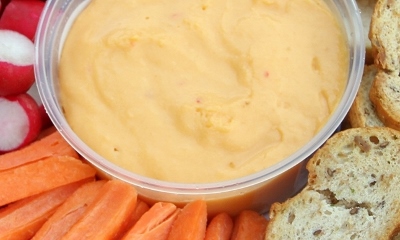Beer Cheese Love: Discovering a Kentucky Tradition
Last June, I found myself in Winchester, Kentucky, near Lexington, at the 6th annual Beer Cheese Fest. Yes, something called a Beer Cheese Fest does exist—in fact, it’s the only one of its kind. Clark County, where Winchester is located, is the birthplace of beer cheese, Ale-8-One ginger-flavored soda, and the Beer Cheese Trail (of course there’s a trail). As the legend goes, in the late 1930s Johnnie Allman owned The Driftwood Inn and served his cousin Joe’s “Snappy Cheese” as a complimentary snack to increase the customers’ cravings for beer. Traditionally, sliced veggies were used for dipping. Today, beer cheese has evolved into more of a cheese spread appetizer that’s served with hard and soft pretzels, crudités, as a condiment, or my favorite, just on its own.
My love for beer cheese began in the spring of 2013. I moved to Northern Kentucky in 2011 and occasionally saw pre-packaged beer cheeses in stores, but it wasn’t until I made a trip to Louisville that everything changed for me. I brunched at Harvest, a popular farm-to-table eatery in Louisville, and on their menu they had beer cheese. But their beer cheese wasn’t the typical cold-packed nuclear orange glob-y substance sold in stores; theirs was a runnier, eggshell color (made with white cheddar cheese) that had local craft beer in it, and it tasted spectacular.
I eventually read about this peculiar Beer Cheese Fest taking place in June, and made a decision to enter their amateur contest (40 people total entered). Anyone can make a batch of beer cheese and enter, just as long as they pay the $10 entry fee and deliver their creation to Winchester City Hall by 11 a.m. on the day of fest. The idea of me not only attending the fest but also possibly winning one of their cash prizes seemed capricious, but it was another thing I could add to my resume: “Garin Pirnia, Award-Winning Beer Cheese Person.” I spent the month prior to the fest preparing what I believed to be my best beer cheese. The recipe seemed simple—beer and shredded sharp cheddar cheese blended together with spices—but it was more complex than that. I eschewed the normal methods and instead mimicked Harvest’s gourmet offering.
-

-

-

-

-

-

-

-

-

-

-

-

-

-

-

-

-

-

-

-

-

-

-

-

-

-

-

-

-

-

-

-

-

-

-

-

-

-

-

-










































